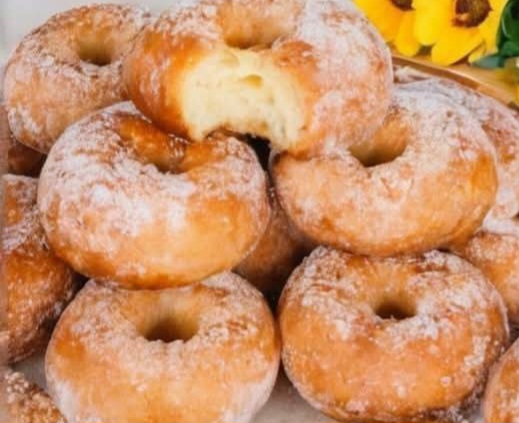Introduction
Doughnuts are a universal comfort food—crispy on the outside, soft and pillowy on the inside, with just the right touch of sweetness. Whether glazed, sugared, or filled, these pastries are a favorite morning indulgence or anytime snack. Making them at home adds a personal touch that makes every bite even more satisfying.
—
Origin and Cultural Significance
The doughnut has roots across various cultures. From Dutch olykoeks to French beignets, fried dough has long been a beloved treat. In America, doughnuts gained fame in the early 20th century and became a staple of diners, bakeries, and coffee shops. They symbolize comfort, community, and even patriotism—WWI “Doughnut Girls” served them to soldiers on the front lines. Today, doughnuts remain an iconic symbol of indulgence and joy.
—
Ingredients Quantity
For the Dough:
3 cups all-purpose flour
2 tablespoons unsalted butter (softened)
7 grams (1 packet) active dry yeast
5 tablespoons granulated sugar
1 cup warm milk (about 110°F / 43°C)
1 egg (optional for richness, not listed but recommended)
1/2 teaspoon salt
Vegetable oil (for frying)
For Coating (Optional):
Granulated sugar or powdered sugar
Cinnamon sugar
Glaze (powdered sugar + milk or water)
—
Optional Additions
1 teaspoon vanilla extract or grated nutmeg for extra flavor
Filled options: jam, custard, or chocolate ganache
Glaze varieties: maple, chocolate, lemon
Toppings: sprinkles, toasted coconut, chopped nuts
—
Tips for Success
Use warm (not hot) milk to activate the yeast properly.
Let the dough rise until it doubles in size for a light texture.
Do not overcrowd the fryer; fry in small batches for even cooking.
Drain excess oil on paper towels to keep them crisp.
Use a kitchen thermometer to maintain oil temperature at 350°F (175°C).
—
Instructions
1. Activate Yeast:
In a bowl, dissolve the sugar in warm milk and sprinkle the yeast over the top. Let it sit for 5–10 minutes until frothy.
2. Make the Dough:
In a large bowl, combine flour, salt, butter, and optional egg. Add the activated yeast mixture. Mix until a soft dough forms. Knead for about 8–10 minutes until smooth.
3. First Rise:
Place the dough in a greased bowl, cover with a damp cloth or plastic wrap, and let it rise in a warm place for 1–2 hours until doubled in size.
4. Shape the Doughnuts:
Roll out the dough on a lightly floured surface to about 1/2 inch thickness. Cut out circles with a doughnut cutter or two round cutters (large and small). Let rest for another 30 minutes.
5. Fry the Doughnuts:
Heat oil to 350°F (175°C) in a deep pan. Fry each doughnut for 1–2 minutes per side until golden brown. Remove and drain on paper towels.
6. Finish:
While warm, toss in sugar or dip in glaze of choice. Let set on a wire rack.
—
Description
These doughnuts are golden and crisp on the outside, with a tender, fluffy interior. Their mild sweetness makes them ideal for coating, glazing, or stuffing. Perfectly satisfying and customizable, they strike a delightful balance between nostalgia and homemade goodness.
—
Nutritional Information (Approx. per doughnut)
Calories: 250
Total Fat: 10g
Saturated Fat: 2g
Cholesterol: 15mg
Sodium: 100mg
Carbohydrates: 35g
Sugars: 8g
Protein: 4g
(Values will vary depending on size and toppings.)
—
Conclusion
Classic homemade doughnuts are a testament to how simple ingredients can create extraordinary results. Whether you’re celebrating or simply craving comfort, this recipe delivers sweet satisfaction every time.
—
Recommendation
Enjoy them fresh and warm for the best experience. Pair with coffee, tea, or hot chocolate. Share with loved ones—they’re sure to disappear quickly!
—
Embracing Healthful Indulgence
To lighten the recipe, try baking instead of frying, use whole wheat flour for added fiber, or reduce the sugar slightly. Remember: a homemade treat enjoyed in moderation can be part of a balanced lifestyle—indulgence doesn’t have to mean guilt.
